The Nebra sky disk, c. 1700 BC
The discovery of the Mauer 1 mandible shows that ancient humans were present in Germany at least 600,000 years ago.[16] The oldest complete hunting weapons found anywhere in the world were discovered in a coal mine in Schöningen between 1994 and 1998 where eight 380,000-year-old wooden javelins of 1.82 to 2.25 m (5.97 to 7.38 ft) length were unearthed.[17] The Neander Valley was the location where the first ever non-modern human fossil was discovered; the new species of human was called the Neanderthal. The Neanderthal 1 fossils are known to be 40,000 years old. Evidence of modern humans, similarly dated, has been found in caves in the Swabian Jura near Ulm. The finds included 42,000-year-old bird bone and mammoth ivory flutes which are the oldest musical instruments ever found,[18] the 40,000-year-old Ice Age Lion Man which is the oldest uncontested figurative art ever discovered,[19] and the 35,000-year-old Venus of Hohle Fels which is the oldest uncontested human figurative art ever discovered.[20] The Nebra sky disk is a bronzeartefact created during the European Bronze Ageattributed to a site near Nebra, Saxony-Anhalt. It is part of UNESCO's Memory of the World Programme.[21]
Germanic tribes and Frankish Empire
The Germanic tribes are thought to date from the Nordic Bronze Age or the Pre-Roman Iron Age. From southern Scandinavia and north Germany, they expanded south, east and west from the 1st century BC, coming into contact with the Celtic tribes of Gaul as well as Iranian, Baltic, and Slavic tribes in Central and Eastern Europe.[22] Under Augustus, Rome began to invade Germania (an area extending roughly from the Rhine to the Ural Mountains). In 9 AD, three Roman legions led by Varus were defeated by the Cheruscan leader Arminius. By 100 AD, when Tacitus wrote Germania, Germanic tribes had settled along the Rhine and the Danube (the Limes Germanicus), occupying most of the area of modern Germany. However, Austria, Baden Württemberg, southern Bavaria, southern Hessen and the western Rhineland had been conquered and incorporated into Roman provinces: Noricum, Raetia, Germania Superior, and Germania Inferior.[23][24][25][26]

Frankish Realm and its expansion. As it was partitioned in 843, West Francia(blue) and East Francia (red) became predecessors of France and Germany, respectively
In the 3rd century a number of large West Germanic tribes emerged: Alemanni, Franks, Chatti, Saxons, Frisii, Sicambri, and Thuringii. Around 260, the Germanic peoples broke into Roman-controlled lands.[27] After the invasion of the Huns in 375, and with the decline of Rome from 395, Germanic tribes moved farther southwest. Simultaneously several large tribes formed in what is now Germany and displaced or absorbed smaller Germanic tribes. Large areas known since the Merovingian period as Austrasia, Neustria, and Aquitaine were conquered by the Franks who established the Frankish Kingdom, and pushed farther east to subjugate Saxony and Bavaria. Areas of what is today the eastern part of Germany were inhabited by Western Slavic tribes of Sorbs, Veleti and the Obotritic confederation.[23]
East Francia and Holy Roman Empire
In 800, the Frankish king Charlemagne was crowned emperor and founded the Carolingian Empire, which was later divided in 843 among his heirs.[28]Following the break up of the Frankish Realm, for 900 years, the history of Germany was intertwined with the history of the Holy Roman Empire,[29] which subsequently emerged from the eastern portion of Charlemagne's original empire. The territory initially known as East Francia stretched from the Rhine in the west to the Elbe River in the east and from the North Sea to the Alps.[28] The Ottonian rulers (919–1024) consolidated several major duchies and the German king Otto I was crowned Holy Roman Emperor of these regions in 962. In 996 Gregory Vbecame the first German Pope, appointed by his cousin Otto III, whom he shortly after crowned Holy Roman Emperor. The Holy Roman Empire absorbed northern Italy and Burgundy under the reign of the Salian emperors (1024–1125), although the emperors lost power through the Investiture controversy.[30]
In the 12th century, under the Hohenstaufenemperors (1138–1254), German princes increased their influence further south and east into territories inhabited by Slavs; they encouraged German settlement in these areas, called the eastern settlement movement (Ostsiedlung). Members of the Hanseatic League, which included mostly north German cities and towns, prospered in the expansion of trade.[31] In the south, the Greater Ravensburg Trade Corporation (Große Ravensburger Handelsgesellschaft) served a similar function. The edict of the Golden Bull issued in 1356 by Emperor Charles IV provided the basic constitutional structure of the Empire and codified the election of the emperor by seven prince-electors who ruled some of the most powerful principalities and archbishoprics.[32]
Population declined in the first half of the 14th century, starting with the Great Famine in 1315, followed by the Black Death of 1348–50.[33] Despite the decline, however, German artists, engineers, and scientists developed a wide array of techniques similar to those used by the Italian artists and designers of the time who flourished in such merchant city-states as Venice, Florence and Genoa. Artistic and cultural centres throughout the German states produced such artists as the Augsburg painters Hans Holbein and his son, and Albrecht Dürer. Johannes Gutenberg introduced moveable-type printing to Europe, a development that laid the basis for the spread of learning to the masses.[34]
In 1517, the Wittenberg priest Martin Luther nailed the Ninety-Five Theses to the church door, challenging the practice of selling of indulgences. He was subsequently excommunicated in the papal bull Exsurge Domine in 1520, and his followers were condemned in the 1521 Diet of Worms, which divided Western Christianity. In 1555, the Peace of Augsburgtolerated the "Evangelical" faith (now called Lutheranism) as an acceptable alternative to Catholicism, but also decreed that the faith of the prince was to be the faith of his subjects, a principle called cuius regio, eius religio. The agreement at Augsburg failed to address other religious creed: for example, the Reformed faith was still considered a heresy and the principle did not address the possible conversion of an ecclesiastic ruler, such as happened in Electorate of Cologne in 1583. However, in practice Calvinists were given protection under the Augsburg Confession Variata modified upon request by Philip Melanchthon.
From the Cologne War until the end of the Thirty Years' Wars (1618–1648), religious conflict devastated German lands.[35] The latter reduced the overall population of the German states by about 30 per cent, and in some places, up to 80 per cent.[36]The Peace of Westphalia ended religious warfare among the Imperial Estates of the Holy Roman Empire.[35] Their mostly German-speaking rulers were able to choose either Roman Catholicism, Lutheranism, or the Reformed faith as their official religion after 1648.[37]
In the 18th century, the Holy Roman Empire consisted of approximately 1,800 territories.[38] The elaborate legal system initiated by a series of Imperial Reforms(approximately 1450–1555) created the Imperial Estates and provided for considerable local autonomy among ecclesiastical, secular, and hereditary states, reflected in the Imperial Diet. The House of Habsburg held the imperial crown from 1438 until the death of Charles VI in 1740. Having no male heirs, he had convinced the Electors to retain Habsburg hegemony in the office of the emperor by agreeing to the Pragmatic Sanction of 1713. This was finally settled through the War of Austrian Succession; in the Treaty of Aix-la-Chapelle, Charles VI's daughter Maria Theresa ruled the Empire as Empress Consort when her husband, Francis I, became Holy Roman Emperor. From 1740, the dualism between the Austrian Habsburg Monarchyand the Kingdom of Prussia dominated the German history.
In 1772, then again in 1793 and 1795, the two dominant German states of Prussia and Austria, along with the Russian Empire, agreed to the Partitions of Poland; dividing among themselves the lands of the Polish–Lithuanian Commonwealth. As a result of the partitions, millions of Polish speaking inhabitants fell under the rule of the two German monarchies. However, the annexed territories though incorporated into the Kingdom of Prussia and the Habsburg Realm, were not legally considered as a part of the Holy Roman Empire.[39][40] During the period of the French Revolutionary Wars, along with the arrival of the Napoleonic era and the subsequent final meeting of the Imperial Diet, most of the secular Free Imperial Cities were annexed by dynastic territories; the ecclesiastical territories were secularised and annexed. In 1806 the Imperium was dissolved; many German states, particularly the Rhineland states, fell under the influence of France. Until 1815, France, Russia, Prussia and the Habsburgs (Austria) competed for hegemony in the German states during the Napoleonic Wars.[41]
German Confederation and Empire
Following the fall of Napoleon, the Congress of Vienna (convened in 1814) founded the German Confederation (Deutscher Bund), a loose league of 39 sovereign states. The appointment of the Emperor of Austria as the permanent president of the Confederation reflected the Congress's failure to accept Prussia's rising influence among the German states, and acerbated the long-standing competition between the Hohenzollern and Habsburg interests. Disagreement within restoration politics partly led to the rise of liberal movements, followed by new measures of repression by Austrian statesman Metternich. The Zollverein, a tariff union, furthered economic unity in the German states.[42]
National and liberal ideals of the French Revolutiongained increasing support among many, especially young, Germans. The Hambach Festival in May 1832 was a main event in support of German unity, freedom and democracy. In the light of a series of revolutionary movements in Europe, which established a republic in France, intellectuals and commoners started the Revolutions of 1848 in the German states. King Frederick William IV of Prussiawas offered the title of Emperor, but with a loss of power; he rejected the crown and the proposed constitution, leading to a temporary setback for the movement.[43]
King William I appointed Otto von Bismarck as the new Minister President of Prussia in 1862. Bismarck successfully concluded war on Denmark in 1864, which promoted German over Danish interests in the Jutland peninsula. The subsequent (and decisive) Prussian victory in the Austro-Prussian War of 1866 enabled him to create the North German Confederation (Norddeutscher Bund) which excluded Austria from the federation's affairs. After the French defeat in the Franco-Prussian War, the German princes proclaimed the founding of the German Empire in 1871 at Versailles, uniting all the scattered parts of Germany except Austria and the German-speaking parts of Switzerland. Prussia was the dominant constituent state of the new empire; the Hohenzollern King of Prussia ruled as its concurrent Emperor, and Berlin became its capital.[43]
In the Gründerzeit period following the unification of Germany, Bismarck's foreign policy as Chancellor of Germany under Emperor William I secured Germany's position as a great nation by forging alliances, isolating France by diplomatic means, and avoiding war. Under Wilhelm II, Germany, like other European powers, took an imperialistic course, leading to friction with neighbouring countries. Most alliances in which Germany had previously been involved were not renewed. This resulted in the creation of a dual alliance with the multinational realm of Austria-Hungary, promoting at least benevolent neutrality if not outright military support. Subsequently, the Triple Alliance of 1882 included Italy, completing a Central European geographic alliance that illustrated German, Austrian and Italian fears of incursions against them by France and/or Russia. Similarly, Britain, France and Russia also concluded alliances that would protect them against Habsburg interference with Russian interests in the Balkans or German interference against France.[44]
At the Berlin Conference in 1884, Germany claimed several colonies including German East Africa, German South West Africa, Togoland, and Kamerun.[45] Later, Germany further expanded its colonial empire to include German New Guinea, German Micronesia and German Samoa in the Pacific, and Kiautschou Bay in China. In what became known as the "First Genocide of the Twentieth-Century", between 1904 and 1907, the German colonial government in South West Africa (present-day Namibia) ordered the annihilation of the local Herero and Namaqua peoples, as a punitive measure for an uprising against German colonial rule. In total, around 100,000 people—80% of the Herero and 50% of the Namaqua—perished from imprisonment in concentration camps, where the majority died of disease, abuse, and exhaustion, or from dehydration and starvation in the countryside after being deprived of food and water.[46][47]
The assassination of Austria's crown prince on 28 June 1914 provided the pretext for the Austrian Empire to attack Serbia and trigger World War I. After four years of warfare, in which approximately two million German soldiers were killed,[48] a general armistice ended the fighting on 11 November, and German troops returned home. In the German Revolution (November 1918), Emperor Wilhelm II and all German ruling princes abdicated their positions and responsibilities. Germany's new political leadership signed the Treaty of Versailles in 1919. In this treaty, Germany, as part of the Central Powers, accepted defeat by the Allies in one of the bloodiestconflicts of all time. Germans perceived the treaty as humiliating and unjust and it was later seen by historians as influential in the rise of Adolf Hitler.[49][50][51] After the defeat in the First World War, Germany lost around 13% of its European territory (areas predominantly inhabited by ethnic Polish, French and Danish populations, which were lost following the Greater Poland Uprising, the return of Alsace-Lorraine and the Schleswig plebiscites), and all of its colonial possessions in Africa and the South Sea.[52]
Weimar Republic and Nazi Germany
Germany was declared a federal republic at the beginning of the German Revolution in November 1918, with 18 federated states in 1925.
On 11 August 1919 President Friedrich Ebert signed the democratic Weimar Constitution.[53] In the subsequent struggle for power, the radical-left Communists seized power in Bavaria, but conservative elements in other parts of Germany attempted to overthrow the Republic in the Kapp Putsch. It was supported by parts of the Reichswehr(military) and other conservative, nationalistic and monarchist factions. After a tumultuous period of bloody street fighting in the major industrial centres, the occupation of the Ruhr by Belgian and French troops and the rise of inflation culminating in the hyperinflation of 1922–23, a debt restructuring planand the creation of a new currency in 1924 ushered in the Golden Twenties, an era of increasing artistic innovation and liberal cultural life. Historians describe the period between 1924 and 1929 as one of "partial stabilisation."[54] The worldwide Great Depression hit Germany in 1929. After the federal election of 1930, Chancellor Heinrich Brüning's government was enabled by President Paul von Hindenburg to actwithout parliamentary approval. Brüning's government pursued a policy of fiscal austerity and deflation which caused high unemployment of nearly 30% by 1932.[55]
The Nazi Party led by Adolf Hitler won the special federal election of 1932. After a series of unsuccessful cabinets, Hindenburg appointed Hitler as Chancellor of Germany on 30 January 1933.[56]After the Reichstag fire, a decree abrogated basic civil rights and within weeks the first Nazi concentration camp at Dachau opened.[57][58] The Enabling Act of 1933 gave Hitler unrestricted legislative power; subsequently, his government established a centralised totalitarian state, withdrew from the League of Nations following a national referendum, and began military rearmament.[59]
Using deficit spending, a government-sponsored programme for economic renewal focused on public works projects. In public work projects of 1934, 1.7 million Germans immediately were put to work, which gave them an income and social benefits.[60]The most famous of the projects was the high speed roadway, the Reichsautobahn, known as the German autobahns.[61] Other capital construction projects included hydroelectric facilities such as the Rur Dam, water supplies such as Zillierbach Dam, and transportation hubs such as Zwickau Hauptbahnhof.[62] Over the next five years, unemployment plummeted and average wages both per hour and per week rose.[63]
In 1935, the regime withdrew from the Treaty of Versailles and introduced the Nuremberg Laws which targeted Jews and other minorities. Germany also reacquired control of the Saar in 1935,[64]remilitarised the Rhineland in 1936, annexed Austria in 1938, annexed the Sudetenland in 1938 with the Munich Agreement and in direct violation of the agreement occupied Czechoslovakia with the proclamation of the Protectorate of Bohemia and Moravia in March 1939.
Kristallnacht, or the "Night of Broken Glass", saw the burning of hundreds of synagogues, the destruction of thousands of Jewish businesses, and the arrest of around 30,000 Jewish men by Nazi forces inside Germany. Many Jewish women were arrested and placed in jails and a curfew was placed on the Jewish people in Germany.[65]
In August 1939, Hitler's government negotiated and signed the Molotov–Ribbentrop pact that divided Eastern Europe into German and Soviet spheres of influence. Following the agreement, on 1 September 1939, Germany invaded Poland, marking the beginning of World War II in Europe.[66][67]
In response to Hitler's actions, two days later, on 3 September, after a British ultimatum to Germany to cease military operations was ignored, Britain and France declared war on Germany.[68] In the spring of 1940, Germany conquered Denmark and Norway, the Netherlands, Belgium, Luxembourg, and Franceforcing the French government to sign an armistice after German troops occupied most of the country. The British repelled German air attacks in the Battle of Britain in the same year. In 1941, German troops invaded Yugoslavia, Greece and the Soviet Union. By 1942, Germany and other Axis powers controlled most of continental Europe and North Africa, but following the Soviet Union's victory at the Battle of Stalingrad, the allies' reconquest of North Africa and invasion of Italy in 1943, German forces suffered repeated military defeats.[66] In June 1944, the Western allies landed in France and the Soviets pushed into Eastern Europe. By late 1944, the Western allies had entered Germany despite one final German counter offensive in the Ardennes Forest. Following Hitler's suicide during the Battle of Berlin, German armed forces surrendered on 8 May 1945, ending World War II in Europe.[69] After World War II, former members of the Nazi regime were tried for war crimes at the Nuremberg trials.[70][71]
In what later became known as The Holocaust, the German government persecuted minorities and used a network of concentration and death camps across Europe to conduct a genocide of what they considered to be inferior peoples. In total, over 10 million civilians were systematically murdered, including 6 million Jews, between 220,000 and 1,500,000 Romani, 275,000 persons with disabilities, thousands of Jehovah's Witnesses, thousands of homosexuals, and hundreds of thousands of members of the political and religious oppositionfrom Germany, and occupied countries (Nacht und Nebel).[72] Nazi policies in German occupied countries resulted in the deaths of 2.7 million Poles,[73] 1.3 million Ukrainians, 1 million Belarusians[74] and an estimated 3.5 million Soviet war prisoners.[74][70] In addition, the Nazi regime abducted approximately 12 million people from across the German occupied Europe for use as slave labour in German industry.[75] German military war casualties have been estimated at 5.3 million,[76] and around 900,000 German civilians died; 400,000 from Allied bombing, and 500,000 in the course of the Soviet invasion from the east.[77] Around 12 million ethnic Germans were expelled from across Eastern Europe. Germany lost roughly one-quarter of its pre-war territory.[13] Strategic bombing and land warfare destroyed many cities and cultural heritage sites.
East and West Germany
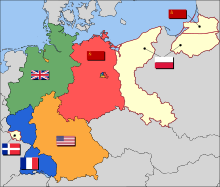
American, Soviet, British, and French occupation zones in Germany and the French controlled Saar Protectorate, 1947. Territories east of the Oder-Neisse line transferred to Poland and the Soviet Union under the terms of the Potsdam Conference.
After Nazi Germany surrendered, the Alliespartitioned Berlin and Germany's remaining territory into four military occupation zones. The western sectors, controlled by France, the United Kingdom, and the United States, were merged on 23 May 1949 to form the Federal Republic of Germany(Bundesrepublik Deutschland (BRD)); on 7 October 1949, the Soviet Zone became the German Democratic Republic (Deutsche Demokratische Republik (DDR)). They were informally known as West Germany and East Germany. East Germany selected East Berlin as its capital, while West Germany chose Bonn as a provisional capital, to emphasise its stance that the two-state solution was an artificial and temporary status quo.[78]
West Germany was established as a federal parliamentary republic with a "social market economy". Starting in 1948 West Germany became a major recipient of reconstruction aid under the Marshall Plan and used this to rebuild its industry.[79]Konrad Adenauer was elected the first Federal Chancellor (Bundeskanzler) of Germany in 1949 and remained in office until 1963. Under his and Ludwig Erhard's leadership, the country enjoyed prolonged economic growth beginning in the early 1950s, that became known as an "economic miracle" (Wirtschaftswunder).[80] The Federal Republic of Germany joined NATO in 1955 and was a founding member of the European Economic Community in 1957.
East Germany was an Eastern Bloc state under political and military control by the USSR via occupation forces and the Warsaw Pact. Although East Germany claimed to be a democracy, political power was exercised solely by leading members (Politbüro) of the communist-controlled Socialist Unity Party of Germany, supported by the Stasi, an immense secret service controlling many aspects of the society.[81] A Soviet-style command economy was set up and the GDR later became a Comeconstate.[82] While East German propaganda was based on the benefits of the GDR's social programmes and the alleged constant threat of a West German invasion, many of its citizens looked to the West for freedom and prosperity.[83]
The Berlin Wall, rapidly built on 13 August 1961 prevented East German citizens from escaping to West Germany, eventually becoming a symbol of the Cold War.[43][84] Ronald Reagan's "Tear down this wall!" speech at the Wall on 12 June 1987 echoed John F. Kennedy's Ich bin ein Berliner speech of 26 June 1963. The fall of the Wall in 1989 became a symbol of the Fall of Communism, the Dissolution of the Soviet Union, German Reunification and Die Wende.[85]
Tensions between East and West Germany were reduced in the early 1970s by Chancellor Willy Brandt's Ostpolitik. In the summer of 1989, Hungary decided to dismantle the Iron Curtain and open its border with Austria, causing the emigration of thousands of East Germans to West Germany via Hungary and Austria. This had devastating effects on the GDR, where regular mass demonstrationsreceived increasing support. The East German authorities eased the border restrictions, allowing East German citizens to travel to the West; originally intended to help retain East Germany as a state, the opening of the border actually led to an acceleration of the Wende reform process. This culminated in the Two Plus Four Treaty a year later on 12 September 1990, under which the four occupying powers renounced their rights under the Instrument of Surrender, and Germany regained full sovereignty. This permitted German reunification on 3 October 1990, with the accession of the five re-established states of the former GDR.[43]
Reunified Germany and the European Union

German unity was established on 3 October 1990.[86] Since 1999, the Reichstag building in Berlin has been the meeting place of the Bundestag, the German parliament.
The united Germany is considered to be the enlarged continuation of the Federal Republic of Germany and not a successor state. As such, it retained all of West Germany's memberships in international organisations.[87] Based on the Berlin/Bonn Act, adopted in 1994, Berlin once again became the capital of the reunified Germany, while Bonn obtained the unique status of a Bundesstadt (federal city) retaining some federal ministries.[88] The relocation of the government was completed in 1999.[89]Following the 1998 elections, SPD politician Gerhard Schröder became the first Chancellor of a red–green coalition with the Alliance '90/The Greens party. Among the major projects of the two Schröder legislatures was the Agenda 2010 to reform the labour market to become more flexible and reduce unemployment.
The modernisation and integration of the eastern German economy is a long-term process scheduled to last until the year 2019, with annual transfers from west to east amounting to roughly $80 billion.[90]
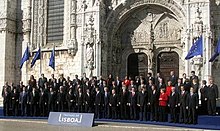
Germany became a co-founder of the European Union (1993), introduced the Euro currency (2002), and signed the Lisbon Treaty in 2007 (pictured).
Since reunification, Germany has taken a more active role in the European Union. Together with its European partners Germany signed the Maastricht Treaty in 1992, established the Eurozone in 1999, and signed the Lisbon Treaty in 2007.[91] Germany sent a peacekeeping force to secure stability in the Balkansand sent a force of German troops to Afghanistan as part of a NATO effort to provide security in that country after the ousting of the Taliban.[92] These deployments were controversial since Germany is bound by domestic law only to deploy troops for defence roles.[93]
In the 2005 elections, Angela Merkel became the first female chancellor of Germany as the leader of a grand coalition.[43] In 2009 the German government approved a €50 billion economic stimulus plan to protect several sectors from a downturn.[94]
In 2009, a liberal-conservative coalition under Merkelassumed leadership of the country. In 2013, a grand coalition was established in a Third Merkel cabinet. Among the major German political projects of the early 21st century are the advancement of European integration, the energy transition (Energiewende) for a sustainable energy supply, the "Debt Brake" for balanced budgets, measures to increase the fertility rate significantly (pronatalism), and high-tech strategies for the future transition of the German economy, summarised as Industry 4.0.[95]
Germany was affected by the European migrant crisisin 2015 as it became the final destination of choice for many asylum seekers from Africa and the Middle East entering the EU. The country took in over a million refugees and migrants and developed a quota system which redistributed migrants around its federal states based on their tax income and existing population density.[96]





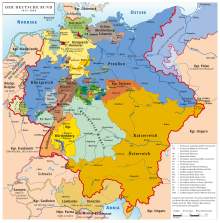


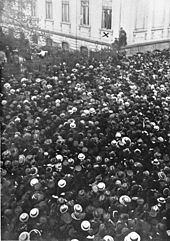
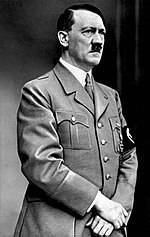




No comments:
Post a Comment